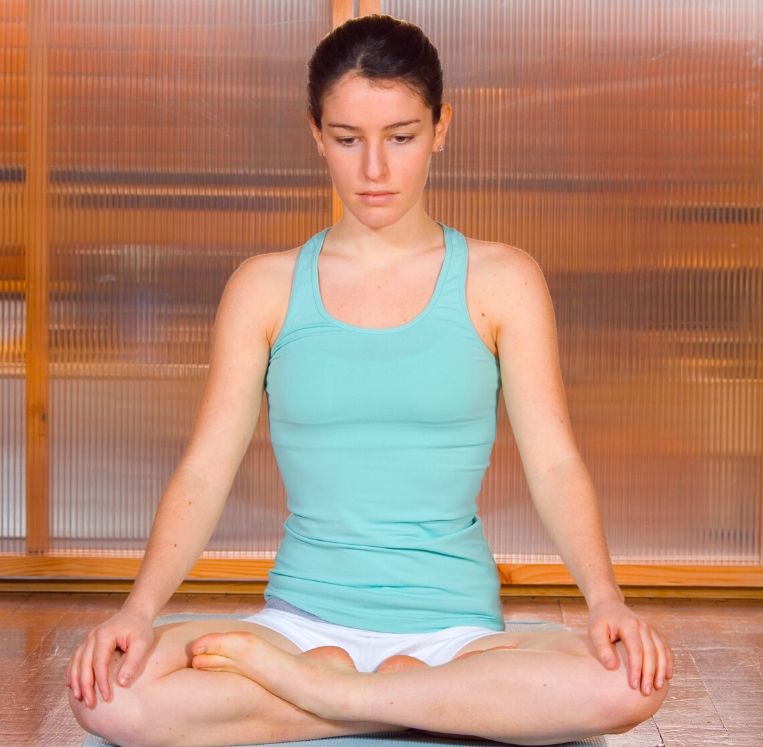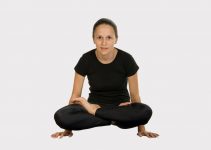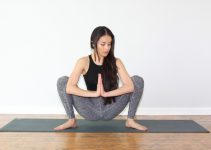
Swastikasana is one of the seated meditative postures. Those who face difficulties in doing Padmasana and Siddhasana (Accomplished Pose) can add this pose in their Meditation Practice.
However, It requires a bit more flexibility than Sukhasana (Easy Pose) in terms of ankle flexion and internal hip rotation, but slightly less challenging in comparison to Padmasana (Lotus Pose).
Therefore, Swastikasan can be considered as a moderate level of difficulty poses for the meditation practice.
Swastikasana Meaning
The term Swastikasana has 3 root words, Su, Asti & Ka. ‘Su‘ means good’; ‘Asti‘ means ‘exist’; ‘ka‘ means ‘to make’. On combining the root terms, Swatikasana can be defined as a pose that makes one exist in a good state of mind.
This asana represents the auspiciousness of practices like Meditation & Pranayama that let a practitioner experience a divine experience.
By placing the legs and thighs under the feet together, erect back while maintaining ease. Makes the Auspicious pose.
– Gheranda Samhita 2.13
In Hinduism, Swastik is a symbol whose right-facing represents the Surya (Sun god), prosperity, and luck, while the left facing represents darkness.
While in swastikasana, placement of our feet resembles the Swastik symbol and so the name is. Therefore, this asana depicts peace and prosperity.
Swastikasana has been described under one of the nine asanas lists of chapter 96 of Vimanarcanakalpa text (some 500 years before the Hatha Yoga Pradipika), attributed to sage Marichi.
Swastikasana Practice Guide
This asana can be practice easily by following the steps below.
Precautions & Contraindications
- Women in their end months of pregnancy should avoid doing this pose, as it may hinder the blood supply to the pelvic and hip area.
- Sciatica patients could be under threat or might worsen the condition as swastikasana presses a sciatic nerve that reduces the supply of blood to the nerve.
- Injury in the region of hip, knees, and ankle avoids doing this asana due to the involvement of leg crossing and hip rotation in asana.
Preparatory Poses
- Bound angle Pose (Baddha Konasana)
- Shoelace Pose
- Easy Pose (Sukhasana)
- Tadasana on tiptoes
- Cradle Pose (Hindolasana)
- Bound Reclined easy Pose (Baddha supta sukhasna)
Swastikasana Steps
- Begin by sitting comfortably on your blanket or yoga mat.
- Now, come into Dandasana by straightening legs and a gap of about a feet in between both of them.
- Erect your back and find the balance. Your foundation should be firm and stable.
- After that, bend your left leg and place the sole under the right thigh and then bend the right leg to put it in between the gap of left thigh and calf.
- Do not let your right heel to touch the pubis. Firmly rest the knees to touch the floor.
- Adopt chin mudra with your hands and rest hand over the knees.
- Maintain the posture as long as it is comfortable. However, you can also practice Dhyana, Japa, and other seated spiritual practices.
- Return to the normal position by unbending both legs, straightening, and a little shaking, respectively.
Props and Modification
- Beginners might face problems in achieving fully swastikasana due to their tight hip muscles. It is advisable to put a folded blanket underneath your sitting bone.
- If knees are unable to touch the floor then one should use a pillow to support them. Make sure do not overstretch or forcibly touch the floor.
- In the case of Lordosis and Kyphosis, the practitioner should rest their back against the wall. You can go for blocks also in order to straight back by placing it between the Scapula.
Follow up Pose
- Reclined One Armed Hero Pose (Eka Bhuja Virasana)
Variation
Siddhasana has one most practiced variation.
Adho Mukha Swastikasana
Adho Mukha swastikasana is a pose assisted with props for the beginners. Practitioners with tight hip joint and rigid hip muscles can do this pose to get better with time.
First of all, come into the ed cross-legged.pose and place a prop like a stack f folded blanket, yoga blocks, pillows at the level of the breast bone. Now, lean over the prop placed in front of your body. Makes sure, hips and sitting bone remain attached to the floor while neck and head relaxed.
Allow the arms to rest on the side of the body and maintain the pose for 2 to 3 minutes. It is also called as downward-facing cross-legged pose.
Swastikasana Benefits
- Practicing swastikasana in meditation regularly harness concentration and memory retention.
- According to one of the research [efn_note] EFFECTS OF SELECTED ASANAS IN HATHA YOGA ON AGILITY AND FLEXIBILITY LEVEL https://www.researchgate.net/publication/26627722_EFFECTS_OF_SELECTED_ASANAS_IN_HATHA_YOGA_ON_AGILITY_AND_FLEXIBILITY_LEVEL [/efn_note], asanas including Swastikasana helps in achieving great flexibility and agility in the practitioners.
- Traditionally swastikasana is used for Meditation and Pranayama, which further multiplies the benefits.
- By restricting the blood flow in lower limbs this asana redirects the blood to the digestive system. Hence, improve the digestive process.
- Meditation in swatikasana for a longer period can result in activation of Mooldhara chakra (Root) and Ajna chakra (Third eye).
- People suffering from varicose veins [efn_note] Varicose veins https://en.wikipedia.org/wiki/Varicose_veins [/efn_note] can practice this asana.
- Swastikasana has a stretching effect over the muscles concerning hip, pubic, inner thighs that prepares a practitioner for the advanced seated posture.
- This asana has a rejuvenating effect over the Nervous system.
- Erect back for longer duration in swastikasana overcomes the defects of backbone example: Lordosis [efn_note] Lordosis https://en.wikipedia.org/wiki/Lordosis. [/efn_note], Kyphosis [efn_note] Kyphosis https://en.wikipedia.org/wiki/Kyphosis [/efn_note], and Scoliosis [efn_note] Scoliosis https://en.wikipedia.org/wiki/Scoliosis [/efn_note], etc, respectively.




